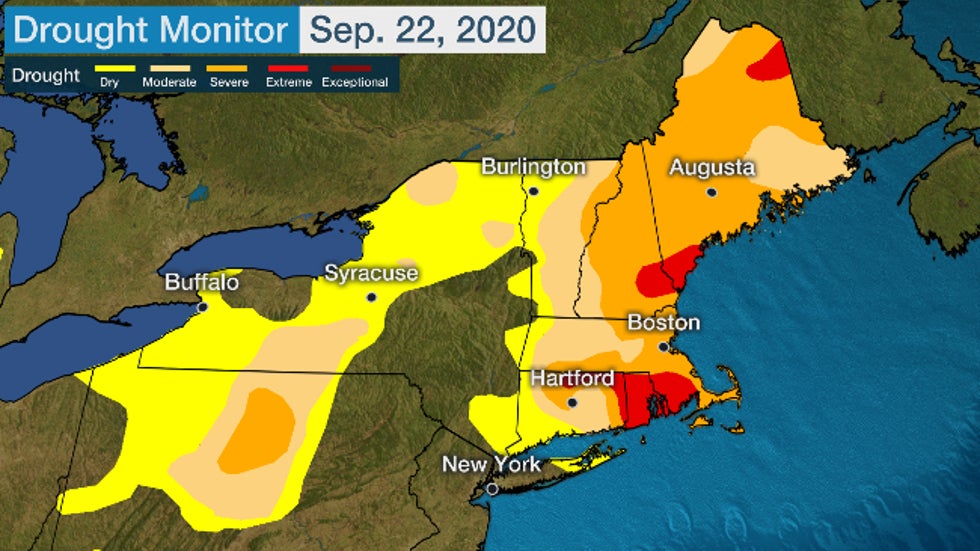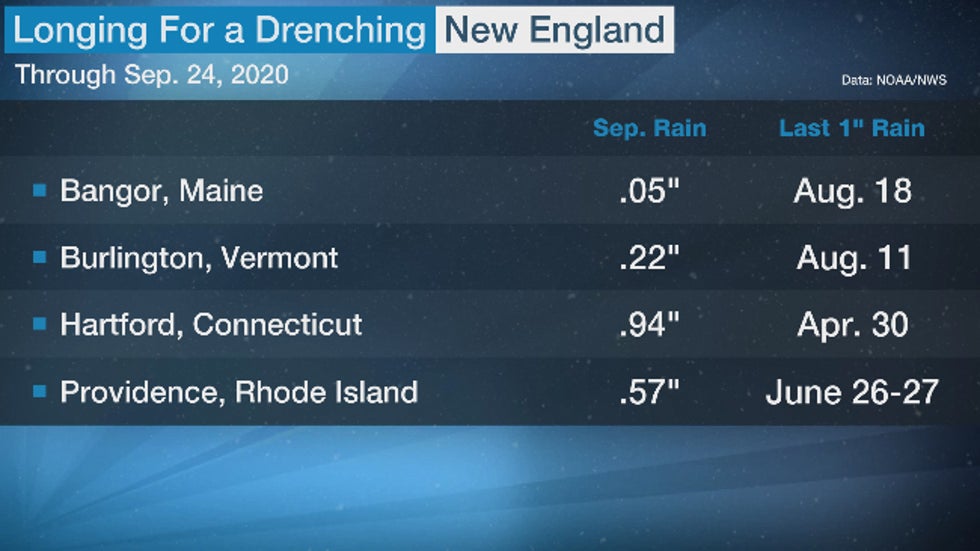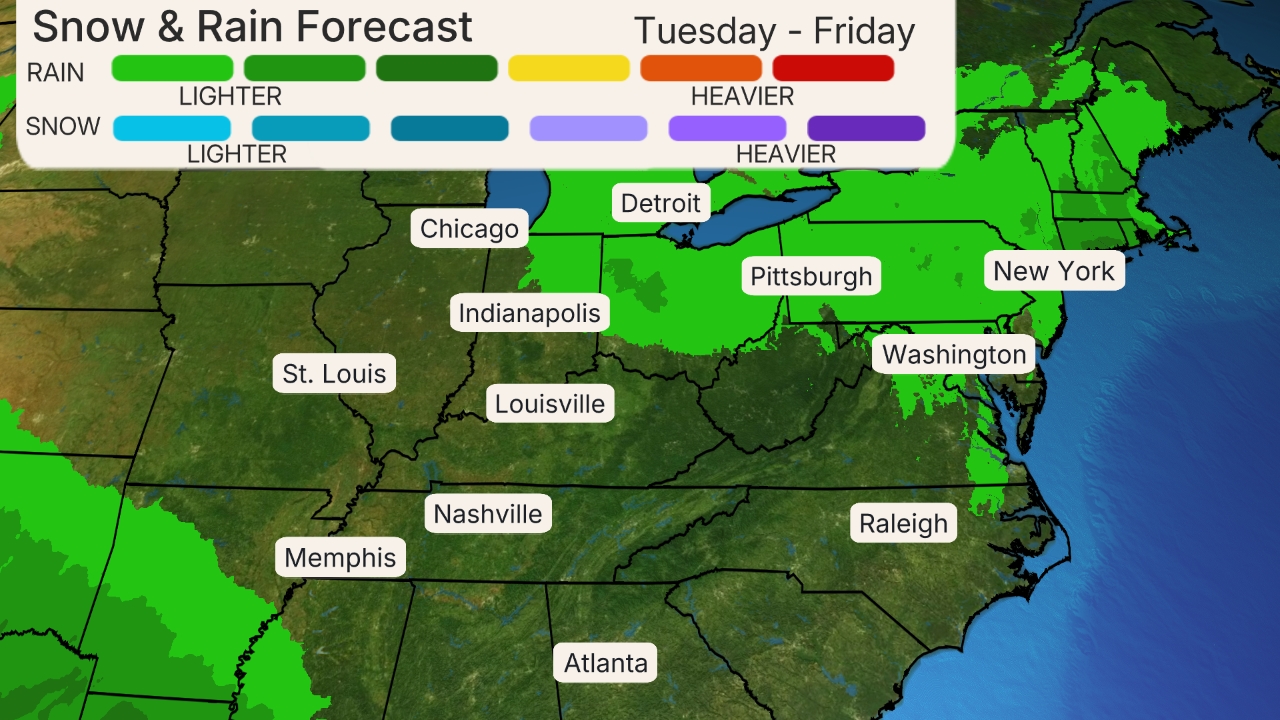Jonathan Erdman
A worsening New England drought will finally experience its first soaking rain in a month or more this week.
As of the September 22, Drought Monitor analysis from the U.S. Drought Mitigation Center showed that virtually all of New England was in drought, with parts of Maine, New Hampshire, southern Massachusetts, Rhode Island and Connecticut in "extreme" drought, the second highest category in the analysis.
It's the first time Rhode Island has been in this second highest "extreme" drought category since the Drought Monitor analysis was launched in 2000.
Furthermore, parts of Maine, New Hampshire and Rhode Island are experiencing a rapidly developing drought known as a flash drought.
Jason Otkin, a drought researcher at the University of Wisconsin-Madison, said he uses at least a two-category worsening in the U.S. Drought Monitor over a four-week period or a three-category intensification over an eight-week period as criteria for a flash drought.
Parts of central and upstate New York, as well as central Pennsylvania, were also in drought.
 The U.S. Drought Monitor analysis as of Sep. 22, 2020 shows virtually all of New England in drought of varying severity. Extreme drought, the second highest category of drought, was in place over parts of Maine, southern New Hampshire, southern Massachusetts, Rhode Island and Connecticut. Areas not yet in drought but rather abnormally dry are shown in yellow.
The U.S. Drought Monitor analysis as of Sep. 22, 2020 shows virtually all of New England in drought of varying severity. Extreme drought, the second highest category of drought, was in place over parts of Maine, southern New Hampshire, southern Massachusetts, Rhode Island and Connecticut. Areas not yet in drought but rather abnormally dry are shown in yellow.Through September 27, it was the driest September-to-date in a number of locations, including Bangor, Maine, and Burlington, Vermont, according to the Southeast Regional Climate Center.
Most New England cities haven't picked up an inch of rain in at least a month.
Residents of Hartford, Connecticut, haven't seen a one-inch-plus rain event since April 30. Manchester, New Hampshire, has a precipitation deficit since mid-May of over 10 inches.

Flash droughts typically offer less time to prepare for impacts such as crop losses, reductions in water supply and increased wildfire risk.
For example, in Maine, the USDA declared Aroostook County a drought disaster, making low-interest federal emergency loans available to those affected.
Forty percent of U.S. Geological Survey streamflow gauges in Maine with at least 30 years of data are at record low levels for this time of year, Nick Stasulis of the New England Water Science Center told the Portland Press Herald.
Over a dozen small wildfires were burning in the state last week, and 1,000 wildfires had been documented so far this year.
Residents in Massachusetts, Connecticut and Rhode Island were asked to conserve water, particularly through reductions in outdoor watering, and told to avoid outdoor burning.
About 100 wildfires have burned in Rhode Island so far in 2020, but have only damaged a couple of buildings, the Boston Globe reported.
Relief Ahead
Fortunately, there is relief on the way.
A pattern change that is ushering in colder air to much of the central and southern U.S. this week will drive a frontal system toward the East Coast.
Warm, moist air ahead of that front will wring out a soaking rain over parts of New England and the rest of the Northeast.
This rain could come in two waves.
One jet-stream impulse ahead of the front will produce heavier rain in New England from later Tuesday into Tuesday night.
Then a second jet-stream disturbance could bring a second brief round of rain to parts of New England Friday and Friday night.
Most of the computer model guidance suggests a majority of New England has a good chance of picking up at least an inch of total rainfall through Friday night.
This should help at least dampen dried out vegetation, reduce the threat of wildfires and replenish rivers.
In other parts of the East, however, this rain could be heavy enough to trigger flash flooding, from the Mid-Atlantic states to the Carolinas, eastern Georgia and parts of north Florida through Tuesday night.
 Rainfall Forecast
Rainfall ForecastThe Weather Company’s primary journalistic mission is to report on breaking weather news, the environment and the importance of science to our lives. This story does not necessarily represent the position of our parent company, IBM.
The Weather Company’s primary journalistic mission is to report on breaking weather news, the environment and the importance of science to our lives. This story does not necessarily represent the position of our parent company, IBM.

No comments:
Post a Comment